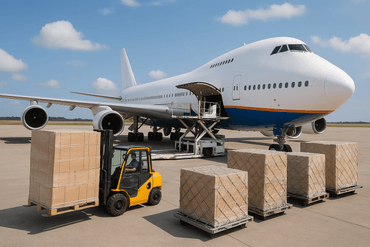
20 shipping acronyms all shippers should know - Infographic



20 shipping acronyms all shippers should know
From IMO 2020 and ELD to GRI and EEI, one way or another, you’ve probably heard it all.
You may be able to put them into context but… just how well do you understand these shipping acronyms?
What’s the difference between HS and HTS codes? Is a 20-foot container the same as a TEU? And just how are SOLAS and VGM related?
Be it with providers, freight forwarders, or agents, you must have come across these terms and concepts a million times. And if you’ve felt lost or confused at any moment, fret not, you’re not alone.
International ocean freight is filled with many such technical terms that easily confuse the occasional and not to mention new importers and exporters unfamiliar with the ins-and-outs of this complex industry.
From required documents and shipment types to international regulations and customs procedures, different players and aspects of maritime transport have its own acronyms and abbreviations.
In this infographic, you’ll find 20 of the most common acronyms that all shippers need to know in order to take on the massive industry that is ocean freight.
![]()
IMO (International Maritime Organization):
Under IMO 2020 regulations, starting 1 Jan 2020, the sulfur content in marine fuels will be capped at 0.5%, down from the current 3.5%.
ELD (Electronic Logging Device) Mandate:
The ELD mandate is US regulation requiring drivers of commercial motor vehicles to log their hours of service electronically.
SOLAS (Safety of Life at Sea):
An international maritime treaty that sets basic measures for the safe construction, equipment, and operation of merchant vessels.
VGM (Verified Gross Mass):
The total gross weight of a shipping container (including dunnage, bracing, and tare). Under SOLAS, shippers are required to declare the VGM of their shipping containers.
P2P (Port to Port):
In port-to-port shipping, cargo is shipped from the port of origin to the port of destination. This excludes transportation services before and after loading.
D2D (Door to Door):
In door-to-door shipping, cargo is shipped from the indicated pick-up location at origin (eg. seller’s warehouse) to the indicated drop-off location (eg. buyer’s warehouse) at destination.
FCL (Full Container Load):
A container shipment that utilizes an entire container. Merchandise shipped under FCL does not share container space with other merchandise.
LCL (Less than Container Load):
Also known as groupage or a shared container, LCL shipments are shipped alongside other cargo in one single shipping container.
LTL (Less than Trucking Load):
Similar to LCL but for land transportation. Various LTL cargoes are grouped and transported together to lower transportation costs.
TEUs (Twenty-Foot Equivalent Unit):
A unit of measurement in maritime transport that is equivalent to the capacity of a 20-foot container.
ETD (Estimated Time of Departure):
The day an international shipment is estimated to depart the port of origin and begin its maritime transit.
ETA (Estimated Time of Arrival):
The day an international shipment is estimated to arrive at the port of destination.
POL (Port of Loading):
The port of origin from which the container is first loaded onto the vessel.
POD (Port of Discharge):
The port of destination where the container is unloaded from the vessel and picked up by the consignee.
GRI (General Rate Increase):
Also known as GRR (General Rate Restoration), a GRI is an increase in maritime freight rates applied by shipping lines when prices are low.
BL o BoL (Bill of Lading):
The Bill of Lading is a document that serves as evidence of a contract of carriage between the shipper and carrier.
ISF (Importer Security Filing):
A regulation that requires maritime cargo imported into the US to be declared 72 hours before vessel departure. Importer, exporter, and cargo information must be included.
EEI (Electronic Export Information):
Electronic declaration of goods valued at above $2,500 that are exported from the US. Formerly known as the SED (Shipper’s Export Declaration).
HS (Harmonized System):
HS codes are six-digit codes that classify goods according to their nature to determine the amount of taxes and duties that need to be paid.
HTS (Harmonized Tariff System):
Seven- to ten-digit codes that classify products into more specific categories than HS codes.
Even though basic, it’s extremely important to fully understand these terms and how they apply to your shipment. Familiarize yourself with them right from the beginning so you get accustomed to seeing and hearing about them throughout your shipping process.
If you would like more information on shipping terms and procedures, we encourage you to visit our help center.
- 1. 20 shipping acronyms all shippers should know
- 2. IMO (International Maritime Organization):
- 3. ELD (Electronic Logging Device) Mandate:
- 4. SOLAS (Safety of Life at Sea):
- 5. VGM (Verified Gross Mass):
- 6. P2P (Port to Port):
- 7. D2D (Door to Door):
- 8. FCL (Full Container Load):
- 9. LCL (Less than Container Load):
- 10. LTL (Less than Trucking Load):
- 11. TEUs (Twenty-Foot Equivalent Unit):
- 12. ETD (Estimated Time of Departure):
- 13. ETA (Estimated Time of Arrival):
- 14. POL (Port of Loading):
- 15. POD (Port of Discharge):
- 16. GRI (General Rate Increase):
- 17. BL o BoL (Bill of Lading):
- 18. ISF (Importer Security Filing):
- 19. EEI (Electronic Export Information):
- 20. HS (Harmonized System):
- 21. HTS (Harmonized Tariff System):
Related Articles


